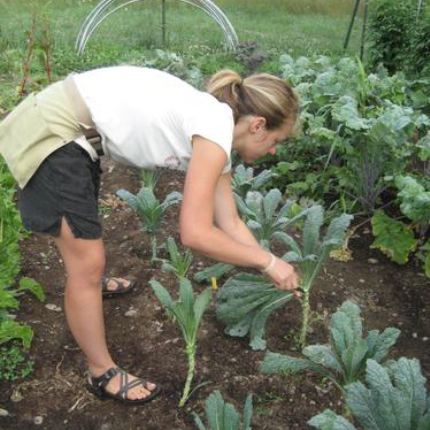
Plant Personality: Kale for the Fall Garden
 The summer solstice marks the perfect seed starting time for many fall harvest crops, and the ever so trendy kale is one of them! While we grow and eat kale in the garden all summer, the flavor really shines in the fall after frost. The light freezing converts some of the starches in the kale leaf to sugars, making it an even sweeter treat.
The summer solstice marks the perfect seed starting time for many fall harvest crops, and the ever so trendy kale is one of them! While we grow and eat kale in the garden all summer, the flavor really shines in the fall after frost. The light freezing converts some of the starches in the kale leaf to sugars, making it an even sweeter treat.
Add a fresh planting of kale to what was planted in the spring, and you will have a bounty come fall. Transplant a fresh crop of starts after a spring crop comes after the ground. The timing works out well to transplant kale after onions, garlic or peas. You can also get kale in after an early planting of snap beans, or lettuce. Avoid transplanting kale after arugula, broccoli, or cabbage to keep flea beetle and cabbage worm pressure down. (For a full review of sowing for fall, check out this helpful post,)
To help you decide which kale is best for your garden, we've complied these notes from our trial garden and experience on each of the varieties we offer.
Dino Kale, AKA Tuscan, Lacinato and Dinosaur Kale, has a deep green hue and crinkly-yet-palatable leaf that makes it popular pick among chefs, home gardeners, and vegetable lovers. As member of the Brassica oleracea species, Dino kale is kin to broccoli, Brussels sprouts and cabbage, and has a milder flavor than some of the Russian kale varieties. While it isn't quite as cold hardy as its kale cousins, it usually survives most of the winter under a blanket of row cover and snow. The seed we sourced for this particular kale variety was selected after trialling several other sources, and we chose it for it hardiness, vigor, and br oad leaves.
oad leaves.
Rainbow Lacinato Kale is a relatively new variety of kale, bred and selected by Frank Morton. This kale is a Lacinato Redbor cross that was stabilized. The Redbor parentage gives this variety added cold hardiness, while keeping many of the qualities that make Lacinato well-loved. This kale has a bit a color and leaf shape variation, and the leaves are pleasantly ruffled, making this kale beautiful when bunched. This kale really shines in the fall, and we highly recommend adding it to your fall garden plan!
Vates Blue Curled Kale is perfect for the ubiquitous kale chip preparation. Compact plants have super frilly light green leaves. The flavor is understated, but the texture is incredible. The frilly leaves maintain their loft when cooked, making them the perfect vehicle for tasty sauces and dressing. Vates is cold hardy and often over winters and will regrow in the spring.
Siberian Kale is perhaps the most mustardy tasty of the varieties we offer. A member of Brassica napus species, Siberian is perhaps the most vigorous and cold hardy. The semi-curly leaves reach 12" with in weeks of being transplanted. If you love kale, and love variety, try Siberian for your fall garden. Not our favorite for raw salads, but delicious cooked, especially as a base mixed with other greens.
Ragged Jack Kale, AKA Red Russian, asla Brassica napus, is extremely cold hardy. If you are looking to extend your kale harvests into deep winter, plant a nice supply of Ragged Jack, and let it grow big and lush, then keep harvesting until you've taken all the larger leaves. Let Ragged Jack overwinter (and it will!) and your plants will reward you with a supply of fresh ragged leaves and kale "rapini," the edible seed-stock shoots that appear in the spring.






